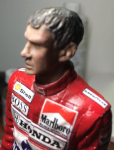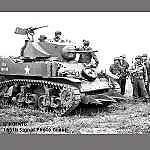H.P.
Hosted by Darren Baker
Loading SSys Schwerlastwagens

Frenchy

Joined: December 02, 2002
KitMaker: 12,719 posts
Armorama: 12,507 posts

Posted: Monday, February 11, 2019 - 05:46 AM UTC
According to Wolfgang Diener's Anstrich und Bezeichnung von Güterwagen book, from 1935 onwards, DR boxcars were painted RAL 8012 :

H.P.
H.P.
Posted: Monday, February 11, 2019 - 07:50 AM UTC
Re-editing here:
OK Frenchy I did not realize RAL 8012 WAS the red-brown we were speaking of
p.s. Thanks Frenchy for the reference date you have given - very good to know!
OK Frenchy I did not realize RAL 8012 WAS the red-brown we were speaking of
p.s. Thanks Frenchy for the reference date you have given - very good to know!

SpeedyJ

Joined: September 17, 2013
KitMaker: 1,617 posts
Armorama: 1,150 posts

Posted: Monday, February 11, 2019 - 02:48 PM UTC
H.P. is right. Only Box cars built for special purpose where grey. From https://de.wikipedia.org/wiki/Güterwagen_der_Deutschen_Reichsbahn
"Nach der gleichen Quelle wurde 1935 die Farbe in rotbraun entsprechend RAL 8012 geändert, wodurch die Güterwagen, vor allem im Vergleich zum vorigen Farbton, mehr braun als rot erschienen. Das Untergestell hatte einheitlich schwarze Farbe. Ab Dezember 1941 wurden die eisernen Dächer in schwarzbrauner Farbe gestrichen und nicht mehr in grün-grau (RAL 7009)."
The roofing colors were changed in 1941.
Kind regards,
Robert Jan
"Nach der gleichen Quelle wurde 1935 die Farbe in rotbraun entsprechend RAL 8012 geändert, wodurch die Güterwagen, vor allem im Vergleich zum vorigen Farbton, mehr braun als rot erschienen. Das Untergestell hatte einheitlich schwarze Farbe. Ab Dezember 1941 wurden die eisernen Dächer in schwarzbrauner Farbe gestrichen und nicht mehr in grün-grau (RAL 7009)."
The roofing colors were changed in 1941.
Kind regards,
Robert Jan

Posted: Monday, February 11, 2019 - 10:45 PM UTC
And for all of us otherwise German impaired:
" the color was changed to reddish brown in accordance with RAL 8012 in 1935, which made the freight wagons appear more brown than red, especially compared to the previous color tone.
The base frame was uniformly black.
In December 1941, the iron roofs became blackish brown painted and no longer in green-gray (RAL 7009). "
" the color was changed to reddish brown in accordance with RAL 8012 in 1935, which made the freight wagons appear more brown than red, especially compared to the previous color tone.
The base frame was uniformly black.
In December 1941, the iron roofs became blackish brown painted and no longer in green-gray (RAL 7009). "
Posted: Monday, February 11, 2019 - 10:56 PM UTC
Further Question:
The above refers to a more reddish color prior to 1935. Do either of you gentlemen have the color spec used before 1935???
The above refers to a more reddish color prior to 1935. Do either of you gentlemen have the color spec used before 1935???

Frenchy

Joined: December 02, 2002
KitMaker: 12,719 posts
Armorama: 12,507 posts

Posted: Monday, February 11, 2019 - 11:19 PM UTC
Quoted Text
The above refers to a more reddish color prior to 1935. Do either of you gentlemen have the color spec used before 1935???
According to the Wikipedia article, the color used before 1935 was RAL 13 a.k.a. RAL 8013 :
Looks quite close to RAL 8012 if you ask me...

H.P.
Posted: Monday, February 11, 2019 - 11:21 PM UTC
Posted: Monday, February 11, 2019 - 11:26 PM UTC
Danke Frenchy

SpeedyJ

Joined: September 17, 2013
KitMaker: 1,617 posts
Armorama: 1,150 posts

Posted: Tuesday, February 12, 2019 - 01:25 AM UTC
Looks pretty impressive. Imagine the tow in Tons of weight!
One Loco? That's what I like about railroads. An endless tow of wagons with a Loco (or more).
Kind regards,
Robert Jan
One Loco? That's what I like about railroads. An endless tow of wagons with a Loco (or more).
Kind regards,
Robert Jan


Frenchy

Joined: December 02, 2002
KitMaker: 12,719 posts
Armorama: 12,507 posts

Posted: Tuesday, February 12, 2019 - 02:22 AM UTC
Quoted Text
I would have to assume this is an emergency movement and the tanks may be going directly into combat upon arrival.
The caption I've found matches your assumption

http://p.calameoassets.com/120429172239-d28c064248e90bd87b4048b3ba1e6087/p44.jpg
H.P.

SpeedyJ

Joined: September 17, 2013
KitMaker: 1,617 posts
Armorama: 1,150 posts

Posted: Tuesday, February 12, 2019 - 03:41 AM UTC
From the pictures you see there are no cables to fasten the Tigers to the flatbed. So running out of time they where for sure. I'm following a build on Missing-Lynx about the SSyms, really detailed and from scratch, (including a debate on the special attachment points for anchoring the heavy beasts) this picture proofs to be a wartime reality, go go go. Only see some wooden chocks, that's it.
Check this link: https://www.tapatalk.com/groups/missinglynx/ssyms-koeln-80t-platform-wagon-railcar-scratch-bui-t318313.html
Very good information and nice build so far.
Kind regards,
Robert Jan
Check this link: https://www.tapatalk.com/groups/missinglynx/ssyms-koeln-80t-platform-wagon-railcar-scratch-bui-t318313.html
Very good information and nice build so far.
Kind regards,
Robert Jan

Posted: Tuesday, February 12, 2019 - 04:28 AM UTC
I wonder if there weren't boards or internal blocking between the treads to keep the tanks for sliding laterally on those flatcars? I think I see some wood blocking under that first Tiger. Considering they did not bother to cross tie these Tigers using the towing clevises there must be something in under there.
Admittedly they are going to get some "bite" between the weight of the tank, those cleated all metal tracks and the wooden deck. But I wouldn't trust that.
I know from bitter experience that if that were a metal load deck that Tiger would slide like a Sherman on ice going around a curve at railroad speeds. If you have a metal deck YOU MUST cross tie a tracked load.
I've seen a Hetzer almost slide off a tilt-back trailer while just trying to climb up on to the tilted metal deck surface. And the Patton Museum has had both the Jagdpanzer IV and the T28 slide off of military (US Army) tank transporters. (Not the Museum's doing but the Army load handlers!) The Jagd was a loading accident but with the T28 someone thought they could safely get away with moving that monster the short distance between the Museum and the Motor Pool without tying it down.
Admittedly they are going to get some "bite" between the weight of the tank, those cleated all metal tracks and the wooden deck. But I wouldn't trust that.
I know from bitter experience that if that were a metal load deck that Tiger would slide like a Sherman on ice going around a curve at railroad speeds. If you have a metal deck YOU MUST cross tie a tracked load.
I've seen a Hetzer almost slide off a tilt-back trailer while just trying to climb up on to the tilted metal deck surface. And the Patton Museum has had both the Jagdpanzer IV and the T28 slide off of military (US Army) tank transporters. (Not the Museum's doing but the Army load handlers!) The Jagd was a loading accident but with the T28 someone thought they could safely get away with moving that monster the short distance between the Museum and the Motor Pool without tying it down.

Frenchy

Joined: December 02, 2002
KitMaker: 12,719 posts
Armorama: 12,507 posts

Posted: Tuesday, February 12, 2019 - 08:07 AM UTC
Quoted Text
On the lower photo the travel tracks are available but are not being utilized.
Sometimes NO tracks are utilized


Here you can notice the outer roadwheels stacked behind the tank :

H.P.
Posted: Tuesday, February 12, 2019 - 02:39 PM UTC
Posted: Tuesday, February 12, 2019 - 04:50 PM UTC

SpeedyJ

Joined: September 17, 2013
KitMaker: 1,617 posts
Armorama: 1,150 posts

Posted: Tuesday, February 12, 2019 - 05:49 PM UTC
I really like that picture. You can see the equipment used to pull the Tiger onto the SSyms. Know I'm curious for the vehicle or maybe the winch pulling the cables.
Kind regards,
Robert Jan
Kind regards,
Robert Jan

Posted: Tuesday, February 12, 2019 - 06:20 PM UTC
Robert, I agree. It looks like the main winch vehicle (or possibly two) are on the ground on the close side of the train. However you can see a second lighter cable coming off the front driver's side corner of the tank pulling towards the off side of the train.
The main winch pull is not along the exact centerline of the flatcar so the main cable will be pulling the tank at a slight angle. That makes the other cable necessary to keep the tank moving forward and not end up going off the side of the railcar.
The main winch pull is not along the exact centerline of the flatcar so the main cable will be pulling the tank at a slight angle. That makes the other cable necessary to keep the tank moving forward and not end up going off the side of the railcar.

Frenchy

Joined: December 02, 2002
KitMaker: 12,719 posts
Armorama: 12,507 posts

Posted: Tuesday, February 12, 2019 - 08:41 PM UTC
Quoted Text
Know I'm curious for the vehicle or maybe the winch pulling the cables.
A a crane-fitted FAMO maybe ? Seems that this one is at least used to hoist the unused tracks :

H.P.

SpeedyJ

Joined: September 17, 2013
KitMaker: 1,617 posts
Armorama: 1,150 posts

Posted: Tuesday, February 12, 2019 - 09:28 PM UTC
It's getting better and better. Now would a Büssing L4500A with Bilstein crane manage to lift such a track? Will check.

Checked the Tiger 1 Information Center...
http://www.alanhamby.com/technical.shtml
Total weight of track per side 2880kg (6349lbs)
Interesting addition for loading the Tigers.
Kind regards,
Robert Jan

Checked the Tiger 1 Information Center...
http://www.alanhamby.com/technical.shtml
Total weight of track per side 2880kg (6349lbs)
Interesting addition for loading the Tigers.
Kind regards,
Robert Jan
Posted: Wednesday, February 13, 2019 - 11:36 PM UTC
Just a few thoughts here:
While I doubt that crane could pick-up a full length of track - it really doesn't have to!
- Track easily breaks into sections so pick up sections of track rather than the whole thing all at once.
OR
- Don't pick it up at all, drag it instead. Drag one end of the track up onto the flatcar using the crane. Then disconnect the cable and move it to the far end of the length of track and pull that end up onto the flatcar, folding the track over itself. (Which seems to be exactly what they are doing in the photo.)
p.s. Note those thick boards running lengthwise on the flatcar. If these are spiked down to the decking they could easily help keep a parked tank from sliding laterally off the flatcar while moving. There also seems to be a crossbar with stop chocks attached at one end of those boards. (The one crewman has his hand on one of the chocks in the photo.)
I'm guessing the use of this type of fixture was a standard shipping practice.
While I doubt that crane could pick-up a full length of track - it really doesn't have to!
- Track easily breaks into sections so pick up sections of track rather than the whole thing all at once.
OR
- Don't pick it up at all, drag it instead. Drag one end of the track up onto the flatcar using the crane. Then disconnect the cable and move it to the far end of the length of track and pull that end up onto the flatcar, folding the track over itself. (Which seems to be exactly what they are doing in the photo.)
p.s. Note those thick boards running lengthwise on the flatcar. If these are spiked down to the decking they could easily help keep a parked tank from sliding laterally off the flatcar while moving. There also seems to be a crossbar with stop chocks attached at one end of those boards. (The one crewman has his hand on one of the chocks in the photo.)
I'm guessing the use of this type of fixture was a standard shipping practice.

Frenchy

Joined: December 02, 2002
KitMaker: 12,719 posts
Armorama: 12,507 posts

Posted: Thursday, February 14, 2019 - 12:03 AM UTC
Quoted Text
Note those thick boards running lengthwise on the flatcar. If these are spiked down to the decking they could easily help keep a parked tank from sliding laterally off the flatcar while moving.
I guess these could be noticed on the top view drawing below :

Looks like the spacing between them is adjustable...
H.P.
Removed by original poster on 02/14/19 - 12:08:16 (GMT).
Posted: Thursday, February 14, 2019 - 12:16 AM UTC
I had wondered what those cross wise grooves or plates in the decking were for????

Frenchy

Joined: December 02, 2002
KitMaker: 12,719 posts
Armorama: 12,507 posts

Posted: Thursday, February 14, 2019 - 12:43 AM UTC
Here's a CAD drawing (courtesy Nacho Roces) showing the "slits" on the deck :

and the Real McCoy (from this ML thread ) :
(from this ML thread ) :

Nacho's impressive SSyms 80 scratchbuilding project
H.P.

and the Real McCoy
 (from this ML thread ) :
(from this ML thread ) :Nacho's impressive SSyms 80 scratchbuilding project
H.P.

SpeedyJ

Joined: September 17, 2013
KitMaker: 1,617 posts
Armorama: 1,150 posts

Posted: Thursday, February 14, 2019 - 02:05 AM UTC
Good to see H.P. refers to this build, I'm following with great interest! But for the tracks to get them on the flatbed, I have my doubts in separate them in lighter sections. Why? It's time consuming and logistic not very plausible.
There is 1 option for loading them to the wagon.
Under the Tiger, when transport tracks are applied it leaves just enough space for the Tiger to position it self, part fits as rolled back. But how to mount the Tiger?
Tigers for transport mount the wagons at the end of the train, or mount sideways from the platform directly, when it is even in height, think that is the most logical way IMHO.
Changing the Fighting Tracks to Transport Track is done on the train station's platform or somewhere close. I've seen some pictures of that and also Tigers mounting the wagons sideways.
Mounting them and getting secured to the wagons, known it's not just one Tiger for loading, leaves time for the crews to organize additional loading of the tracks and other equipments belonging to the Tiger. Using a winch, like from a Famo, seen earlier today is very plausible.
Keeping in mind it is not a 2 hours job, these logistic operations, when time was still on their side, maybe took a day or even more, but were clockwork logistic performances of the Reichsbahn.
Will search if I can find that picture of changing the tracks, it is somewhere on my Mac, pretty interesting with a crew showing how they did that. also the storage with the chocks behind the Tiger(think I posted that already) shows how organized the worked.
Kind regards,
Robert Jan
There is 1 option for loading them to the wagon.
Under the Tiger, when transport tracks are applied it leaves just enough space for the Tiger to position it self, part fits as rolled back. But how to mount the Tiger?
Tigers for transport mount the wagons at the end of the train, or mount sideways from the platform directly, when it is even in height, think that is the most logical way IMHO.
Changing the Fighting Tracks to Transport Track is done on the train station's platform or somewhere close. I've seen some pictures of that and also Tigers mounting the wagons sideways.
Mounting them and getting secured to the wagons, known it's not just one Tiger for loading, leaves time for the crews to organize additional loading of the tracks and other equipments belonging to the Tiger. Using a winch, like from a Famo, seen earlier today is very plausible.
Keeping in mind it is not a 2 hours job, these logistic operations, when time was still on their side, maybe took a day or even more, but were clockwork logistic performances of the Reichsbahn.
Will search if I can find that picture of changing the tracks, it is somewhere on my Mac, pretty interesting with a crew showing how they did that. also the storage with the chocks behind the Tiger(think I posted that already) shows how organized the worked.
Kind regards,
Robert Jan

 |














